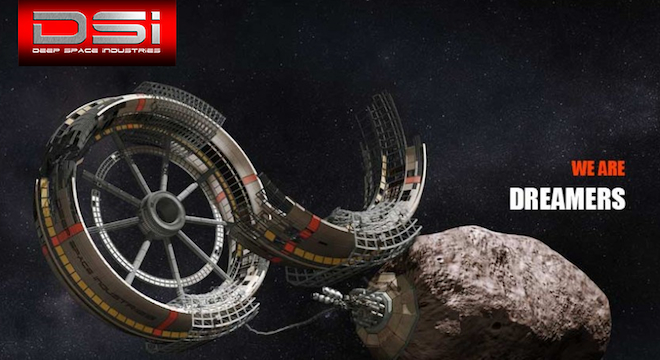Updated 12:58 p.m. EST, Monday, January 28
The race is officially on to mine the first asteroids in outer space.
On Tuesday, a new American spacefaring company, Deep Space Industries, Inc., publicly unveiled its plans to mine near-earth asteroids, develop a “microgravity foundry” to produce metal parts from ground up asteroid ore, and eventually, construct entire outer space refineries to produce fuel for spacecraft from the other volatiles contained in asteroids.
“Our overall plan is to get into this field [asteroid mining] as it begins and it is beginning today,” said Rick N. Tumlinson, chairman of the board of Deep Space Industries, during a press conference held at the Santa Monica Museum of Flying in California on Tuesday.
But in announcing its entry into the nascent asteroid mining industry, Deep Space Industries, Inc., is following on the heels of another company, Planetary Resources, that first disclosed its plans to prospect and mine asteroids back in April 2012.
Deep Space’s plans are distinctly different and grander than those of its would-be space mining competitor, however. Here’s a video from the company promoting its vision for an asteroid mining industry:
Watch the company’s full announcement in Santa Monica below, via Spacevidcast on YouTube:
For one thing, Deep Space plans to start its operations as early as 2015 by launching several tiny unmanned spacecraft called FireFlies on one-way missions to near-earth asteroids, to sample the mineralogical makeup of promising mining candidates and send data back to Earth. These spacecraft, which have a target weight of 55 pounds, will be based on the low-cost “cubesats,” or tiny satellite technology currently being used by space agencies and institutes around the world, but with additional propulsion and controls. Check out a concept image below via Deep Space Industries:

Following the first successful FireFly trips, Deep Space says that as early as 2016 it will launch larger, 77-pound, unmanned spacecraft called DragonFlies, capable of returning actual asteroid samples to Earth for up-close analysis. Check out a concept image of those spacecraft below, via Deep Space Industries:

The next stage of the company’s ambitious proposal is “full-scale commercial operations,” which could come as early as 2020. They would be conducted using a much larger unmanned spacecraft known as the Harvestor, which should be capable of transporting thousand of tons of asteroid minerals per year back to Earth or Earth orbit, where they can be processed. Here is a concept image of a Harvestor from Deep Space Industries:

By 2020, “we’ll start producing products for customers,” said Deep Space CEO David Gump in Tuesday’s press conference. Initially, that won’t be refined metals such as platinum, but rather “volatiles, water, things that can be turned into propellant,” Gump explained. Deep Space Industries aims to sell the propellant to communications satellite companies, which currently must pay premium to get fuel for their satellites into space.
“The biggest market is communications satellites,” Gump said. “It costs $10,000 per pound to get propellant up for geosynchronous orbit.”
After that, though, Deep Space’s business plan gets even loftier: The company wants to help develop a “permanent communications platform” in outer space that’s “just like the cellular system” back here on Earth, according to Gump. That means outfitting communications satellites with more equipment — transponders, solar cells, spot beam antennae — to allow for more stable, faster and more powerful satellite communications.
“That means the next generation of HDTV can be delivered by satellite,” Gump said. “You can get highspeed Internet anywhere on the planet.”
From there, Deep Space wants to move into building solar-powered satellites directly in orbit, capable of collecting more than enough sunlight to power their own operations and beam the rest back to Earth as clean electricity for the rest of terrestrial civilization.
Ultimately, Deep Space wants to develop the first outer space propellant refinery (concept screenshot below), to produce enough fuel to power other government and private space station’s from the likes of Bigelow Aerospace, and crewed missions back to the Moon and to Mars.

To do all this, the company will also rely on a patent-pending new proprietary 3D printing technology it calls the “MicroGravity Foundry,” which unlike its terrestrial 3D metal powder printing counterparts, doesn’t require gravity to operate. It will be capable of grinding asteroid material up and relatively quickly transforming it into “structural parts, fasteners, gears, and other components to repair in-space machinery and to create new space infrastructure, such as solar power satellites,” as Deep Space’s website explains.
“In the in long run we anticipate an in-space manufacturing facility that will be able to manufacture tools,” said Stephen Covey, a member of Deep Space Industries’ board of directors and the inventor of the technology, during the press conference.
Covey was formerly director of research and development for Applied Innovation Inc. and a previous software consultant for the U.S. Defense Department. But he is just one of the varied and experienced, if eclectic leadership roster at Deep Space: Tumlinson is a co-founder of several commercial spacefaring associations including MirCorp, the private organization that took over the Russian Mir Space Station for a brief controversial period before the station was de-orbited in 2001. Gump, too, is a founder of several private spacefaring companies and also wrote and directed the first TV ad filmed aboard the International Space Station (a Father’s Day spot).
Deep Space Industries is backed by capital investment funding and also aims to raise further investments and contract money from customers. The company did not disclose how much money it has raised so far, but Gump said the company had been formulated six months prior to the announcement, in summer 2012.
It will operate at least one office out of McLean, Virginia and is actively searching for other office locations in either California or Houston, Texas, as it revealed Tuesday.
Updated to add the video ad.






